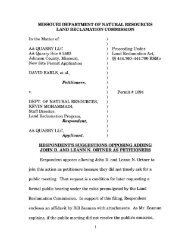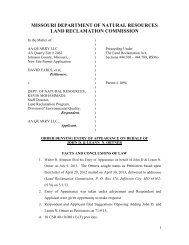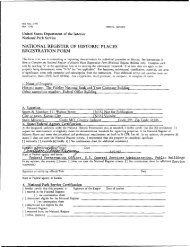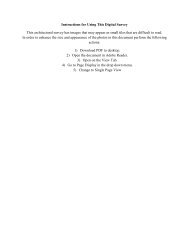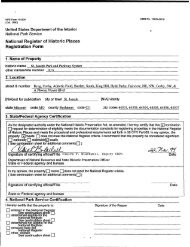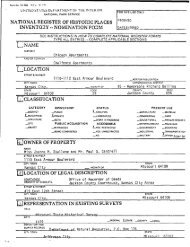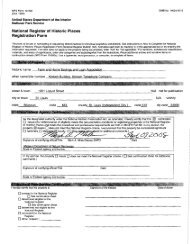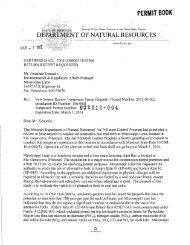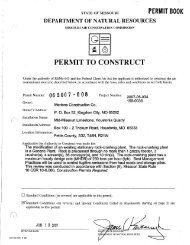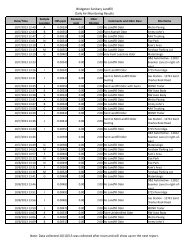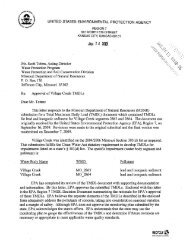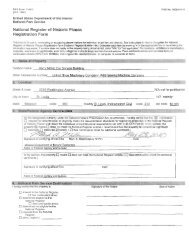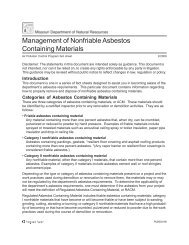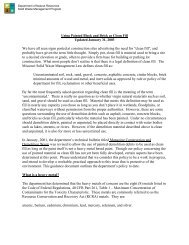V - Missouri Department of Natural Resources
V - Missouri Department of Natural Resources
V - Missouri Department of Natural Resources
You also want an ePaper? Increase the reach of your titles
YUMPU automatically turns print PDFs into web optimized ePapers that Google loves.
18<br />
cell which produced the maximum reported rainfall. This rainfall was 21 inches in 36 hours,<br />
<strong>of</strong> which 13 inches was reported by newspapers (The Kansas City Times, July 20, 1965, p. 1, 5)<br />
to have fallen in a 3-hour period starting at 6:00 P.M. (1800 hours) on Sunday night, July 18.<br />
Rockport was the only town in the basin to suffer extensive flood damage. Water from Boney<br />
Branch and Rock Creek inundated about 60 percent <strong>of</strong> the city, covering the entire business dis<br />
trict to a depth <strong>of</strong> 2 to 3 feet. Damage to crops, roads, and bridges occurred in the vicinity<br />
<strong>of</strong> and downstream from Rockport in the lower part <strong>of</strong> the basin. Flood pr<strong>of</strong>iles for Rock Creek<br />
are shown in plate 1.<br />
Tarkio River basin<br />
Flooding on the Tarkio River was not severe, and only minor flooding occurred in various<br />
low-lying areas. Two distinct peaks occurred during the storm period <strong>of</strong> almost the same mag·<br />
nitude, 9,200 and 9,440 cfs, at the streamflow station at Fairfax. These peaks were consider·<br />
ably less than have been recorded on other occasions.<br />
Nodaway River basin<br />
This flood was minor on the Nodaway River except in the lower end <strong>of</strong> the basin below the<br />
streamflow station at Burlington Junction where more than 7,000 acres <strong>of</strong> croplands were flooded<br />
and heavy damage to roads and bridges resulted.<br />
Platte River basin<br />
The One Hundred and Two River basin, a major tributary to the Platte River from the west,<br />
received heavy rains below Maryville, as indicated by figure 3. At the streamgaging station<br />
on One Hundred and Two River near MaryVille, where the maximum flood in 33 years <strong>of</strong> record<br />
occurred on June 14, 1947, the July 19, 1965 flood peak was 10 feet below that <strong>of</strong> the 1947 flood.<br />
The flood pr<strong>of</strong>ile (pl. 2) shows that from Bolckow, 24 miles downstream from Maryville, to the<br />
mouth <strong>of</strong> the One Hundred and Two River, flood crest elevations for the 1965 flood ranged from<br />
2 to 10 feet higher than the 1947 flood elevations. Rosendale (pop. 234), near the center <strong>of</strong><br />
an area where 18 inches <strong>of</strong> rain occurred in the 3-day period, was heavily damaged by the flood<br />
ing <strong>of</strong> 17 residences, 8 businesses, and I public building.<br />
The Little Platte River, in the southeastern part <strong>of</strong> the Platte River basin, was severely<br />
flooded throughout its entire length. Considerable damage was done to crops, roads, and bridges<br />
in the rural stretches <strong>of</strong> the stream. The Little Platte River at Smithville reached a stage<br />
<strong>of</strong> 44.8 feet, 21.5 feet above flood stage. This was 7.4 feet above the previous highest known<br />
flood <strong>of</strong> July 1947. Plate 2 shows the flood pr<strong>of</strong>iles <strong>of</strong> both the 1965 and the 1947 floods.<br />
smithville, a community <strong>of</strong> 1,254 population, was the major flood damage center <strong>of</strong> the storm



